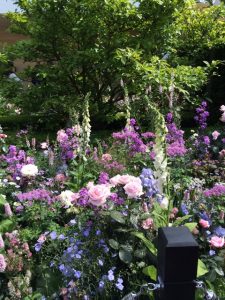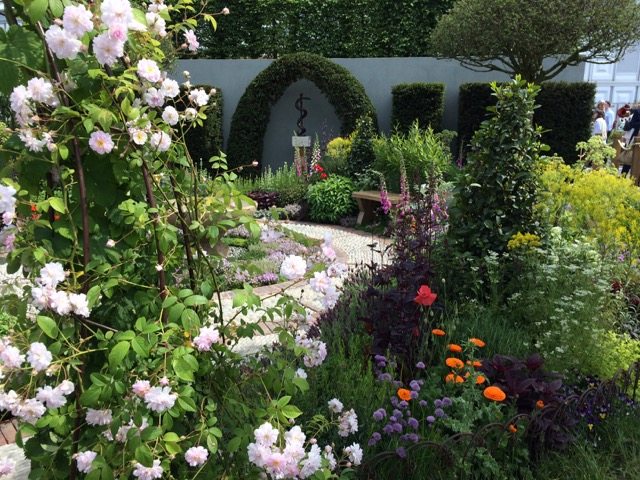August 8th, 2016
 The Chelsea garden themes were as varied as the riots of color and different plants displayed: historic gardens, commemorative gardens (for the Queen’s 90th birthday), squares of different plants of matching colors, and squares of similar plants of different colors – roses, orchids, tulips – it went on and on. Then there were wilder plantings, like woodland meadows. Some were unique – an old mill next to a stream with a bucket of colored wool spilling out, surrounded by plants for dyeing.
The Chelsea garden themes were as varied as the riots of color and different plants displayed: historic gardens, commemorative gardens (for the Queen’s 90th birthday), squares of different plants of matching colors, and squares of similar plants of different colors – roses, orchids, tulips – it went on and on. Then there were wilder plantings, like woodland meadows. Some were unique – an old mill next to a stream with a bucket of colored wool spilling out, surrounded by plants for dyeing.My favorites were the St. John’s Hospice Garden – “A Modern Apothecary,” and the LG “Smart Garden” – both filled with flowering plants of pink and purple pastel hues. I was not alone – both gardens had won Silver-Gilt Medals from the Royal Horticultural Society. Both were meant as tranquil places, and each also had a second theme – the Smart Garden merged modern technology with the natural environment, and every element in the Modern Apothecary garden had been shown to have some beneficial effect on healing.
As its name suggests, the Apothecary Garden contained herbs and plants used for their medicinal properties – fragrant purple-flowered rosemary, lavender, and thyme; daisy-like flowers of feverfew, white flowering hawthorne, golden marigold, and delicate blue flowered flax.
The layout too, and architectural elements also had healing aspects. A pale pink climbing rose trellis arch marked the entrance to the garden. In an alcove adorning the back of the garden stood a bronze statue of a snake winding around the staff of Aesclepius – the universal symbol of healing and medicine.  Connecting the two was a brick paved path lined with a few oak benches.
Connecting the two was a brick paved path lined with a few oak benches.
This garden’s layout – an entrance arch, a focal point (the statue), a path, a place to sit, is one that is used in all the sacred, healing gardens created by the TKF Foundation: an Annapolis, Maryland-based non-profit dedicated to creating healing, sacred gardens throughout the US. The arch defines the space, and helps keep it sacred. The focal point draws you towards it and guides your meanderings along the paths, in quiet meditation.
The places to sit also provide an opportunity for quiet contemplation. The TKF Foundation’s signature benches, placed in all their sacred spaces, are large semi-circular oak, made from oak barrels that Founder and CEO Tom Stoner had purchased from a defunct brewery. He simply cut the large barrels in half and re-assembled them to make the benches. Under each bench is placed a waterproof notebook where visitors can record their thoughts. The “Green Road” healing forest glen at the Walter Reed National Medical Center in Bethesda, Maryland, currently under construction in partnership with the TKF Foundation, will have these features too.
I have always found gardens to be my sanctuary, my places of peace – places I escape to when I am stressed or distressed. Some of my favorites, which I describe in Healing Spaces, are the Bishop’s Garden at the National Cathedral in Washington, DC; the Huntington Gardens in LA; and a lovely mature Japanese garden on the roof of a hotel in downtown LA’s ‘Little Tokyo.’ You would never guess that the tall trees that shade an azalea-lined stream and the high waterfall splashing into a pebble beach, all sit atop the third floor of a convention space attached to the hotel. All these gardens have the same features, on different scales – an entrance-way, a winding path, and benches on which to sit, and many have water elements.
Perhaps my love of gardens comes from my mother – although I didn’t inherit her love of gardening. I would rather enjoy the fruits of someone else’s labors. My mother tended our garden in Montreal with love and dedication, rejoicing in the young shoots that pushed up through the dry leaves and melting snow in early spring, welcoming the spring and summer rains that fed those plants, and carefully protecting them in the fall before the winter’s cold and storms.
Now that the Chelsea Flower Show is over, the St. John’s Modern Apothecary Garden will be moved to its permanent home at St. John’s Hospice, a palliative care hospital in St. John’s Wood, London. There, patients will be able to find respite, even at the end of life, and their families and loved ones will find a place of peace with them.